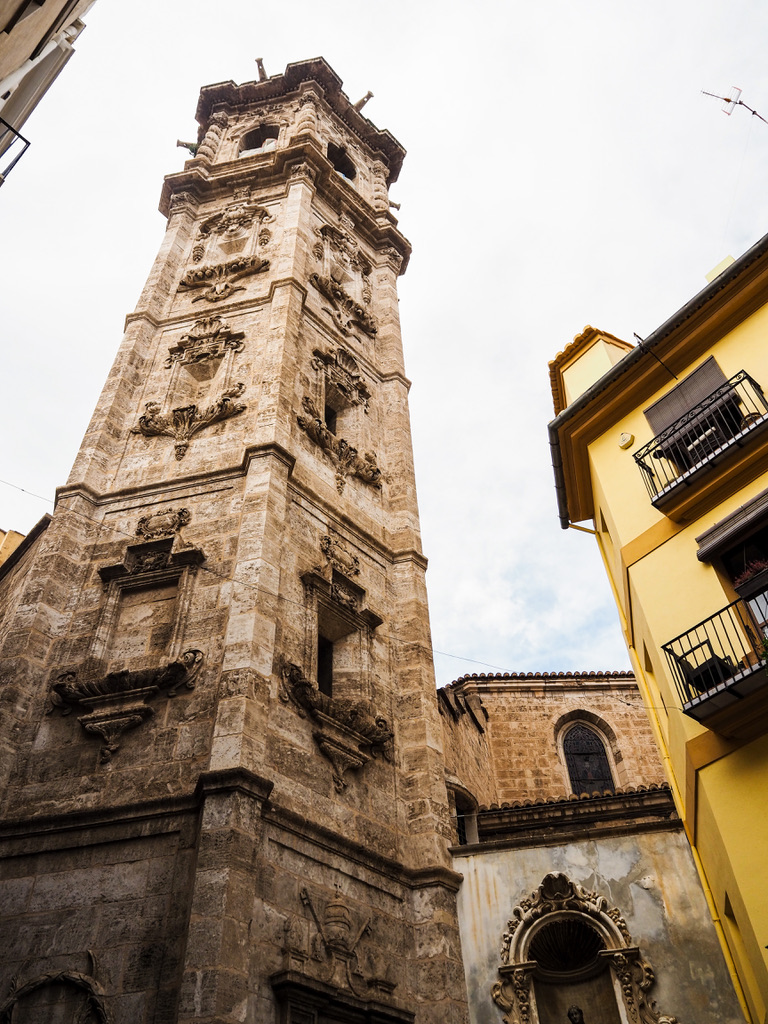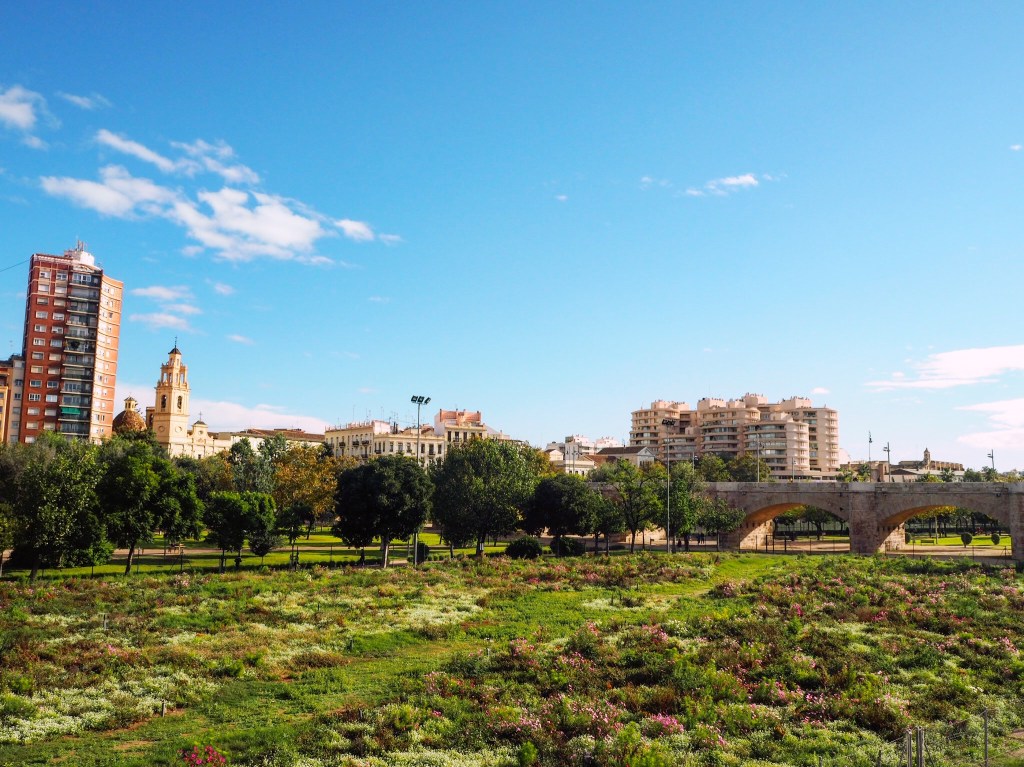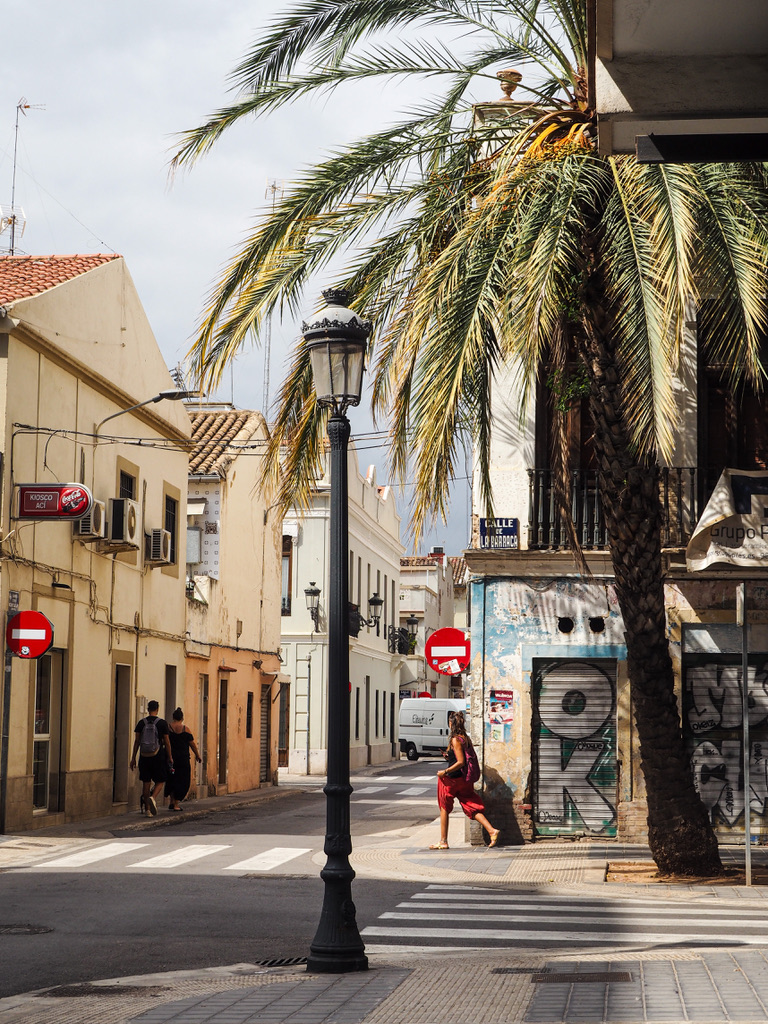The streets of València old town- known locally as la Ciutat Vella- are a beautiful maze overflowing with sumptuous smells, sights and sounds. The city is also famous for its futuristic architecture, but the elegant old town is where València’s story began; whether you’re here to soak up the historic atmosphere or a sumptuous plate of paella, there’s no shortage of things to see and do.
*This site uses affiliate links, where I may earn a small commission at no cost to the reader.
A very brief introduction to València
Located on the sun-drenched east coast of Spain, across the sea from the Balearic Islands of Ibiza and Mallorca, València is a mediterranean paradise. The city was founded (like many a city around these parts) by those cheeky old Romans, all the way back in 138BC. Put bluntly, this city is very, very old.
Throughout the middle ages, control of València and the surrounding area was wrestled- and sometimes peacefully given- back and forth and left and right from Christians to Arabs and back to Christians, and it’s these various medieval eras that had huge influence on the architecture and design of old town València, with solid but ornate gothic towers and narrow winding streets.
By the early 20th century, Spain was in rather a spot of political turmoil, and from 1936-1937 València became the temporary capital of the Republic instead of Madrid. Eventually Franco overthrew the government, and the entire country suffered under his nationalist dictatorship for almost 40 years. During Franco’s brutal regime, the teaching or speaking of the Valèncian language (Catalan, which originated in Barcelona and Catalunya) was forbidden, as were political parties, and there was a censorship of artistic and cultural expression. The regime decided which art was permissible, and this ultimately focused on nationalism and traditional religious values.
Over the last few decades this beautiful city has had a complete cultural resurgence, proving that its identity may have been trodden down, but it was never lost. València old town is packed with history, and outside of the city centre the City of Arts and Sciences is a futuristic hub for science and creativity.





Is València old town walkable?
Right, pals. Let’s hone back in on València old town. One of the most brilliant things about the Ciutat Vella is that it is incredibly easy to explore on foot, in fact that’s part of the reason that València is becoming such a popular destination for shorter city breaks in Spain. The historical centre is compact and yet filled with things to see and do (and eat), and if you do want to get out of the old town, public transport in València is extensive and easy to navigate.
Find out more information about public transport in València.
How to get from València airport to València old town
Getting from València airport to València old town couldn’t be easier, pals! There are two Metro lines which connect the airport to the city: Line 5 and Line 3. The full journey takes 20 minutes, and a one way ticket costs €1 for the metrocard, plus €4.80 for the journey. (Although there is a bus as well, the journey takes around double the time, and the price is the same.)
To get a taxi from the airport to València will cost around €25-30. (2025)
Can you walk from València old town to the beach?
There are plenty of beach towns within driving distance of València, but the city also does have its own really beautiful, expansive, sandy beach. And I’m sorry to be the bearer of bad news, pals, but you cannot walk from Valencia old town to the beach. Alas! (Especially not during summer time, the temperature can really push the limits around here.)
It takes about 15 minutes by tram to reach Las Arenas: look for Line 6.
Read my full guide to the beach and El Cabanyal, València’s historic barrio by the sea.


The Best Things to Do in València Old Town
My first visit to València lasted only one day in early Autumn, and although we managed to see and do a lot within la Ciutat Vella that day, I’d recommend spending at least three or four days in the city to experience it properly. I’ve loved discovering hidden gems during the many times I’ve returned to València, and this is definitely a place to be soaked in slowly, not sped through.
Climb El Miguelete for a 10/10 view
This gothic bell tower is part of the Cathedral of València, and from the very top of the octagonal structure you can admire views all the way across the old town’s rooftops and away into the distance. The tower was constructed between 1381 and 1424, although up until 1238 a mosque stood on the exact same spot, and before that a Visigothic temple…and before that, a Roman temple. Either this is a particularly sacred and spiritual spot, or each religious group really wanted to wipe out the memory of the last one. (Take your pick, pals.)
The entrance to El Miguelete is located right next to the main cathedral entrance. Entrance fee for the tower is €3 per person, and the tower is open from 10am until 6.45pm daily, with last entrance half an hour before closing time.


Let’s talk about silk, baby
Back in the day, silk was kind of a big deal in València. In fact, it’s part of the reason that the city became so prosperous.
During 700 years of Islamic rule, Arabs had brought with them all their knowledge and methods of silk production, from growing mulberry trees (mulberries being the main diet for silkworms, don’cha know) to weaving the silk fabrics, and the silk industry continued to succeed long after the Muslims had left.
By the 15th century, the city was in its ‘Golden Age’ of silk, and Valèncian silk was renowned across Europe and into the Middle East. The Silk Exchange (La Lonja de la Seda) is a Valèncian Gothic building where silk and other luxurious fabrics were traded right up until the 18th century. These days its a UNESCO World Heritage Site, and well worth a stop when you’re in the city.
Entry to the Silk Exchange is €2. Opening hours are 10am-7pm Monday-Saturday and 10am-2pm on Sundays.
Visit the old city gates
Back in the medieval times, València was surrounded by a sturdy wall, built to keep enemies out. There were originally several gates built into this wall, but only two of those gateways remained intact after the wall was eventually demolished: the Torres de Serranos and the Torres de Quart. These are some truly chunky towers, but the real reason they survived the demolition was because they were both in use as prisons.
It’s possible to visit either one of the two torres. Both are open from 10am-6.30pm Monday to Saturday, and 10am-1.30pm on Sundays. Entrance is €2.

Eat a Valèncian paella
Obviously it goes without saying that when in Spain, you should order a paella. It just makes sense, doesn’t it? Not only is València considered to be the birthplace of paella, but paella here is slightly different to other Spanish regions: the key ingredients of a true Paella Valènciana are chicken and rabbit, with not a hint of seafood to be seen. (Although you’ll occasionally see snails listed as an ingredient as well.) It’s thought that the dish originated when the Muslims of Al-Andalus began growing rice in this region, and its popularity then spread across Spain.
Bear in mind that making a paella takes a while, so when you order one in restaurant it will often come with a longer waiting time attached.

Drink a horchata
This sweet, refreshing drink is an absolute delight, and if you want it the Valèncian way, it should be accompanied with fartons- which are a type of pastry dipped in sugar.
Horchata is made from tigernuts, or chufas en Español, which originated in North Africa and were brought to València by (you guessed it) the Muslims. These little nuts are considered a superfood high in natural minerals, and horchata is made in a similar way to other nut milks. You’ll find it on sale at most coffee shops and ice cream parlours around the city, but there are also several dedicated horchaterías to be found. The most well-known is València old town is probably la Horchatería Santa Catalina, which has a beautiful tiled exterior and is almost 200 years old. (They really know what they’re doing, clearly.)


Take a stroll through the Jardín del Turia
The story of el Jardín del Turia is a great example of making lemonade out of lemons. Years ago the river Turia ran right through the heart of València; which is all well and good until you consider the flooding. In 1957 the river’s banks burst and caused a flood so extreme that over 60 people were killed. The city came up with a grand plan to reroute the river, and by the end of the next decade the plan was complete and the old riverbed was dry.
The next question was, what to do with the newly dried up riverbed, and the local government proposed transforming it into a beautiful concrete highway! Let’s face it, that would have been a complete tragedy, wouldn’t it? The residents didn’t like this idea, and eventually a new plan was formed: the riverbed would be transformed into a park, running right through the heart of València, and bordering part of València old town.
This park is absolutely stunning, and the way it runs through the city like a bright green river is downright wonderful. Naturally the park is free to visit, and open all year round.


Marvel at the Marqués de dos Aguas Palace
The Palacio del Marqués de Dos Aguas actually houses the Ceramics Museum, which I’m yet to visit. (Although it’s only €2 to enter, so I’ll be checking it out on my next trip to València.) But even if you don’t venture inside, or aren’t interested in the ceramics and art within the building’s walls, this building is an absolute stunner.
Although the palace was originally constructed in the 15th century, it’s been modified countless times since, and its current glorious facade is nothing short of spectacular. Intricate frescoes and carvings envelope the building, and the windows are framed with ornate balconies; it’s a work of art all around.


Just explore the streets
Alright, maybe lost is a strong word, but the compact layout of València old town, and the fact that it’s so very filled with beauty, means that this is an ideal city to get lost in. Dedicate at least a few hours to aimlessly wandering, without much of a plan of where to go. Part of València’s vibe is that although it’s busy, it’s a little less frantic and a little more lived-in than some of its Spanish counterparts, and this part of the reason that I love it so very much.




If you have time to get out of València Old Town
If you have a longer stay in València, and fancy getting out of the old town, it’s worth heading to the barrio of El Cabanyal, which is right next to the beach at Las Arenas. Many of the houses are adorned with geometric tiles in the Spanish modernist style, and it’s a lovely spot to feel a more ‘local’ vibe in the city. (Or tuck into some authentic tapas)
Read my complete guide to El Cabanyal.



More from Spain:
A day trip from Málaga to Mijas
The Most Beautiful Building in Barcelona

